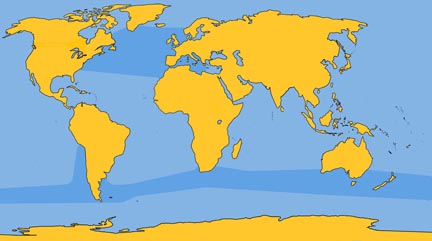Family: Delphinidae
Genus: Globicephala
Species: G. melas (Traill, 1809)
Taxonomic Note: The southern population is occasionally referred to as Globicephala malaena edwardii, an alleged subspecies. The allegations came as a result of animals observed with all Globicephala melas characteristics except for shorter flippers.
The long-finned pilot whale is one of the largest cetaceans ever kept in captivity. Whether as a show animal or the subject of exhaustive military exercises, the pilot whale has mastered varied and complex tasks. An extremely friendly animal, it is also one of the most graceful and fluid swimmers when viewed underwater.
Pilot whales were named by European fishermen who believed that herring schools could always be found in the waters beneath the swimming mammals and followed the small whales in the hopes of catching fish. They are known to strand in great numbers on beaches, and theories suggest that they follow a single male herd leader that, if ill, may strand, taking the entire herd with him.
Physical Description: The body is stocky and extremely elongated, with an exaggerated vertical deepening of the keel at the peduncle. The head is rounded and bulbous with slightly defined lips and no discernible beak.
Color: They are jet black with a white anchor-shaped patch on the chin narrowing thinly down the vertical region to the anus.
Fins and Flukes: They possess a long, low, falcate dorsal fin located far to the front of the mid-back region. The flippers are very long and sickle-shaped. The flukes are relatively small slightly rounded at the tips, with a definite median notch.
Length and Weight: Males may exceed 20 ft (6 m) in length and weigh 7,000 lb (3,200 kg); females reach 18 ft (5.5 m) and 6,500 lb (3,000 kg).
Teeth: They have 8 to 10 large conical teeth nearly 2 in (5 cm) long in each side of the upper and lower jaw.
Feeding: Predominantly squid and schooling fish.
Breathing and Diving: Pilot whales breath very quickly, seldom exposing more than the top of the head and the dorsal fin. They are known to dive as deep as 2,000 ft (600 m).
Mating and Breeding: Calves of 6 ft (1.8 m) are born after a gestation period of 16 months. Lactation lasts for 20 months. Males reach sexual maturity in 11 years; females in 6.5 years. Birthing apparently takes place every 3 to 5 years and may occur at any time during the year.
Herding: Long-finned pilot whales are gregarious animals herding in large numbers of up to several hundred individuals.
Distribution: In the Northern Hemisphere they are distributed as far north as Newfoundland, as well as the American and European sides of the temperate Atlantic Ocean. In the Southern Hemisphere they are found in cool, temperate waters.
Migration: Apparently there is a migration from cold water to warm, but little is known.
Natural History Notes: Males of the species are thought to live 40 years; females between 42 and 50 years.







